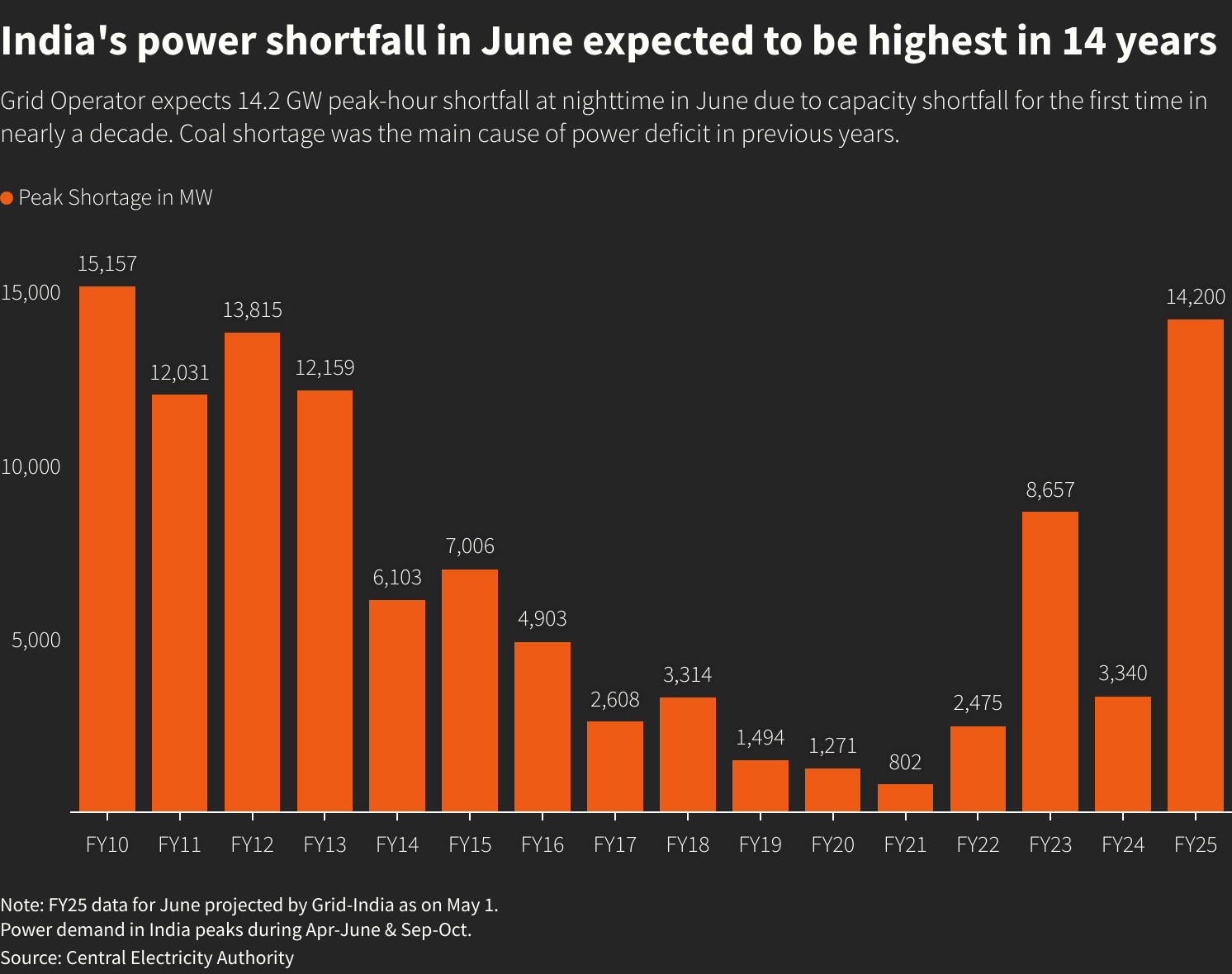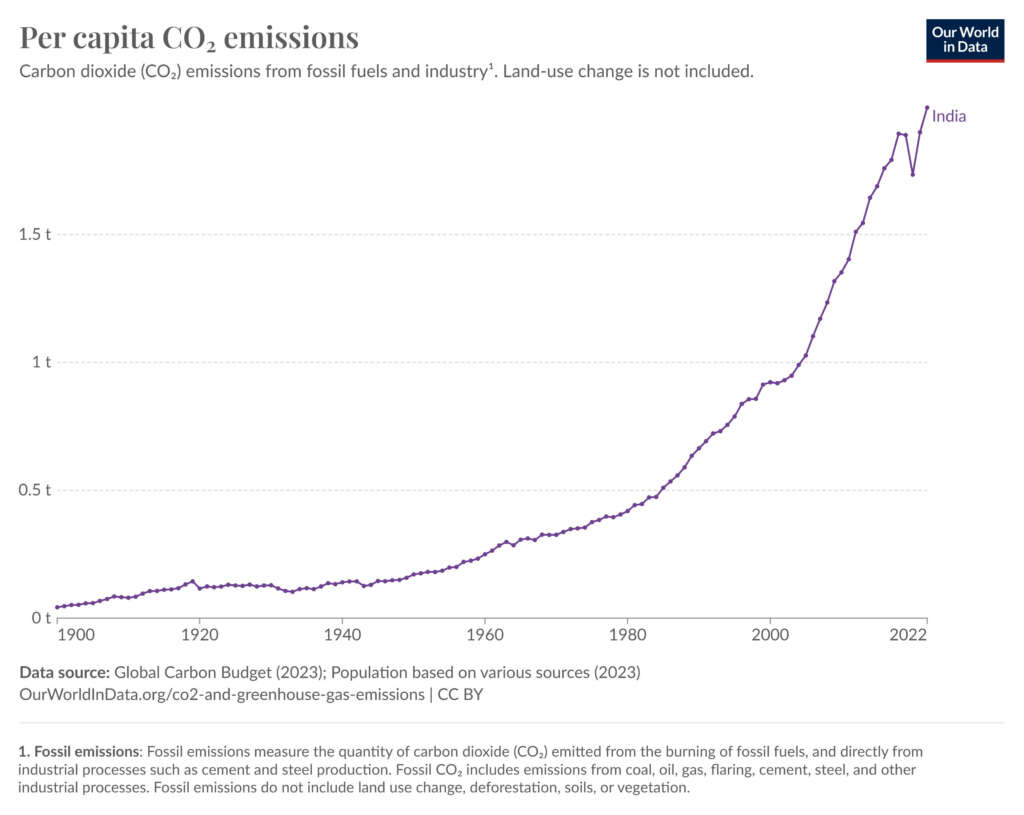Key Takeaways
India is facing its largest electricity shortfall in over a decade this June and is reviving idled coal plants to keep the lights on at night.
India has installed increasing amounts of solar generation, including the world’s largest floating solar plant, but solar does not produce electricity at night.
India’s hydroelectricity output has fallen in the face of a drought.
India is arguing that it must use coal because its per capita carbon dioxide emissions are lower than many countries, but those emissions have doubled in the last 20 years.
India is one of many nations beginning to understand that meeting the U.N.’s demands for climate action is threatening its energy security.
Like China, India’s growing economy will have to rely on coal-fired generation for its electricity as its massive subsidies for solar power have not produced the electricity supply needed. India is projecting its biggest power shortfall in 14 years for June night-time hours. The expected shortfall is the largest since 2009-2010. Existing coal-fired power plants and solar plants are projected to meet the nation’s electricity demand during daytime hours, but after the sun goes down, a shortage could result as India’s hydroelectricity output fell at the steepest pace in four decades in the fiscal year ended March 31, and its renewable energy generation is flat. To avoid outages, India is deferring planned plant maintenance and is re-opening 5 gigawatts of idled coal plant capacity. Besides the slump in hydropower generation, the commissioning of 3.6 gigawatts of new coal-fired plants, which were to be operational before March, was delayed.

India’s maximum night-time demand for June is projected at 235 gigawatts with nearly 187 gigawatts of thermal capacity available and about 34 gigawatts of renewable capacity. Last month, the power ministry invoked emergency rights for the first time to direct gas-based and imported coal-based power plants to operate at full capacity.
Because of the Paris Accord, Prime Minister Narendra Modi’s administration had slowed coal capacity growth to focus on the green energy transition and meet its 2070 net zero emission goals. Despite those goals, plans for new coal power plants in the country gathered momentum last year. Private Indian firms expressed interest in building at least 10 gigawatts of coal-fired power capacity over a decade, ending a six-year drought in significant private involvement in the sector. Adani Power, JSW Group and Essar Power are among the companies that have told India’s power ministry they would expand old plants or develop stalled projects facing financial stress. Prime Minister Narendra Modi’s government, which has cited energy security concerns and low per-capita emissions to defend India’s coal dependence, has been trying to attract private investment to increase its coal-fired capacity by 80 gigawatts by 2032.
Coal-fired power plants currently account for half, or about 215 gigawatts of India’s total installed capacity of 430 gigawatts, with renewables accounting for 135 gigawatts and hydro making up 47 gigawatts. While coal accounts for about half of India’s capacity, its share of generation is much higher—at around 75 percent. Capacity factor (the ratio of the electrical energy produced to the electrical energy that could have been produced based on a unit’s capacity) is an issue with solar energy as its inherent intermittency results in much lower daily generation than operating at full capacity would indicate. India’s capacity factor for solar is estimated at no higher than 20 percent of installed capacity. That compares to a capacity factor for coal plants that can be 80+ percent.
India has built the world’s largest floating solar plant in Madhya Pradesh. The 600-megawatt plant, built on the backwaters of Omkareshwar Dam, was badly damaged by a summer storm on April 9. The plant’s solar panels sit on top of floats that are supposed to adapt to changes in water currents. The damaged floating plant is one of three developed near the dam. The storm that damaged it had winds reported at 50 kilometers per hour, which is just over 31 miles per hour–relatively tame winds. According to the National Weather Service, “extreme” wind threats are winds ranging from 74 miles per hour to 95 miles per hour; winds under 39 miles per hour is not considered much of a threat. The project was supposed to be the world’s largest floating solar PV plant, but instead, it is a stark reminder of the limits of renewable energy and the dangers of prioritizing those plants over practical realities.
Despite India’s plans to reach net zero carbon dioxide emissions by 2070, the trend in the country’s emissions’ output is in the opposite direction. India’s per capita emissions are 10 times higher than they were in 1960 and have doubled in just the last 20 years. India has 1.42 billion people –over four times the population of the United States.

Conclusion
India was trying to meet its Paris Accord goals with renewable energy, but found that it needs coal-fired power plants to continue to have reliable energy to fuel its economy and to provide more power for its people. Due to a slump in hydroelectric generation and delayed coal-fired power units coming on-line, India is trying to avoid a shortfall in electricity supply this month during night-time hours when solar can no longer generate power as the sun does not shine at night. Despite Prime Minister Modi’s plans to reduce coal dependency, he is finding that solar power comes with problems as moderate winds severely damaged the world’s largest floating solar facility in India. Solar power is not an end-all—a lesson that President Biden needs to also learn as he is forcing the United States to meet net zero carbon dioxide emissions in the power sector by 2030.



